"`It's quite hard to destroy the Earth.'
Does that statement make anyone else nervous? I mean, does that sound like experience talking?"
-from the comments on the LHC at slashdot
Last week, I started an open thread, giving you the chance to ask about how certain we were about the validity of certain physical theories. (The thread is still open, FYI.) Here's the ranking scale I'm using, along with a few examples of where certain ideas currently fall.
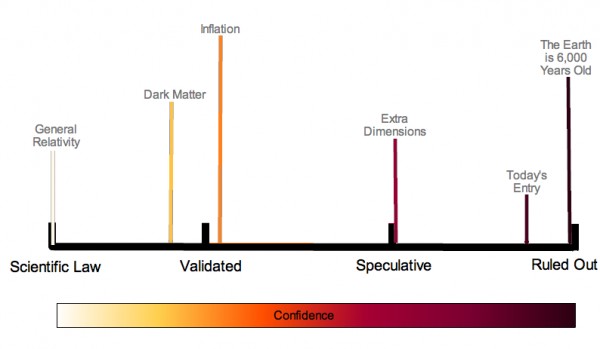
And some of the most intriguing questions that came up were about the Higgs: what is it, how does it give mass to things, and is it even a certainty? Let's take a deeper look, starting at the basics.
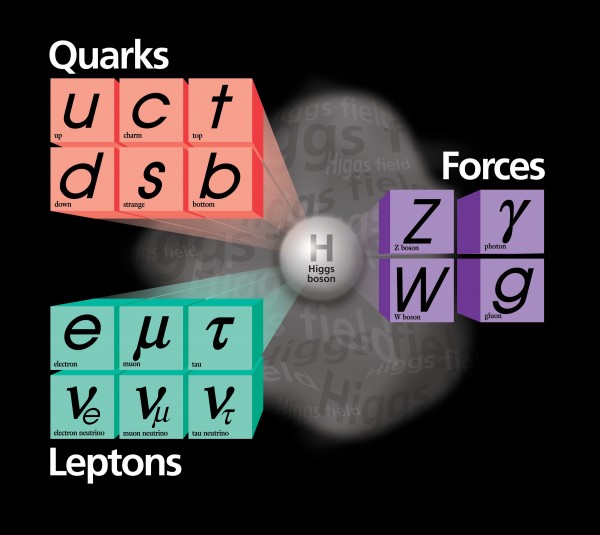
These are all of the different types of particles that make up the known Universe, and I'll give you a basic introduction to them below. There are four different types:
- The Quarks: In the upper left-hand corner, the quarks are tiny, massive subatomic particles. They make up protons, neutrons, and the nuclei of all the elements in the Universe. The also make up fun, weird little oddities (like mesons and heavy baryons) that we've discovered thanks to particle accelerators and cosmic rays. Each of the six quarks comes in three different colors (red, white, and blue), two different spins (+½ and -½), and in both matter and anti-matter varieties, for a total of 72 possible states. Ultimately, the quarks are responsible for the majority of the matter we know of in the Universe. (Not including dark matter.)
- The Leptons: In the lower right-hand corner, the leptons are much lighter than their quark counterparts. The most famous, the electron, is responsible for electricity and for turning those protons, neutrons, and nuclei into atoms. The six leptons can all exist in matter and anti-matter varieties, but while the electron, muon, and tau can have two different spins (+½ and -½), the three neutrinos don't get a choice; the "matter" neutrinos are all spin -½ and the "antimatter" ones are all spin +½. They all have masses, including neutrinos, which shouldn't. (Indicating that there is something beyond the standard model.) All told, there are 15 different types of leptons.
- The Force Carriers: On the right, these are the particles responsible for the forces between the quarks and leptons. There's the photon, responsible for the electromagnetic force, which you know best in its role as light. It doesn't come in matter and anti-matter varieties, though, as it's its own antiparticle, and the only two states it can have are from its different spins (+1 and -1; 0 is forbidden because it's massless). There are the W's (electrically charged + and -, with spins +1, 0, and -1) and the Z (neutral, with spins +1, 0, and -1), the particles responsible for the weak force and for radioactive decay. And then there are the gluons, the massless "glue" that's responsible for the strong nuclear force. It holds protons, neutrons, and nuclei together. Gluons also have two different spins (+1 and -1), eight different color combinations, and no electric charge. All told, this means there are 27 different states for the force carriers, which nails down all of the known forces except gravity.
- The Higgs: Without this, the standard model doesn't make sense. Yet, it's the last part of it that hasn't been discovered. If it exists, it would interact with (or "couple to") the quarks, the charged leptons, and the weak force carriers, giving mass to all of them, but not with the photons or gluons, leaving them massless.
Now, those are the particles that live in the standard model's zoo.

The quarks, leptons, and force carriers have all been discovered, and they've all been tested with extraordinary rigor. The last remaining mystery? Where does mass come from?

According to theory, the Higgs couples to quarks, leptons, and the W's and Z's, giving them mass, but not to photons or gluons. In theory, it also couples to itself, meaning that it, itself, has mass.
And what is that mass? Well, without having successfully made and detected one, we're not sure. But, based on the standard model, we can place limits on its mass.
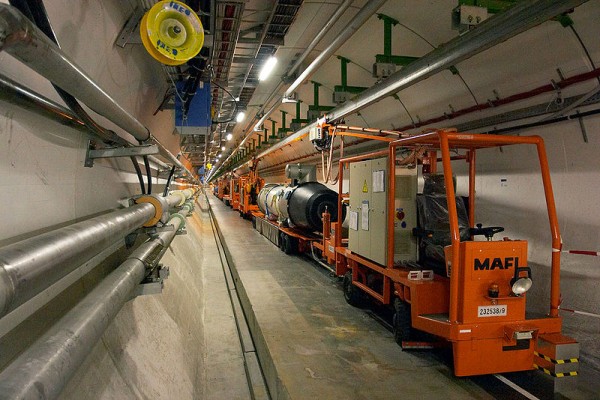
Before the LHC, there was LEP, which was the same underground, 27 km-long tunnel used for the LHC today. Only, instead of protons, they collided electrons and positrons. Based on measurements from LEP, the Higgs would have been discovered if it had a mass below 114 GeV, so we can be confident that if the Higgs exists, it's heavier than this. (A GeV, by the way, is a unit of energy. A proton, for comparison, has a rest-mass energy of just less than 1 GeV, or 0.938 GeV, to be more precise.)

It also can't be too heavy. Precise measurements of the electromagnetic and weak interactions tell us, that if the standard model is valid, the Higgs can't be too heavy, either. From limits from multiple colliders, the Higgs must be lighter than 186 GeV as well. So there's only a narrow range left where we can expect to find the Higgs. And it's a question of who'll get there first.
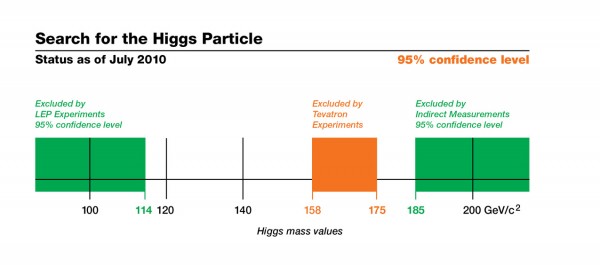
You may have seen, in the news this week, the Tevatron (the giant accelerator at Fermilab, in Batavia, Illinois) has ruled out part of that mass range! If the Higgs exists, it's either lighter than 158 GeV or heavier than 175 GeV. The Tevatron will continue to both run and look at the data from its current run, and will either extend those limits or -- hopefully -- find the Higgs! But if not...
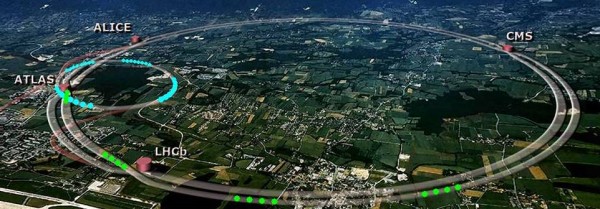
The LHC -- the giant collider on the border between France and Switzerland -- ought to find it, or be able to rule out the Standard Model's Higgs entirely. Either way is incredibly interesting.
Although it's still speculative, most of us expect that the Higgs will be found. Most of the theoretical particle physicists I know, in fact, expect that when it is found, it will weigh in somewhere around 140 GeV, although that's based on some speculative assumptions. It's hard to imagine that the standard model, good for all of these billions of collisions we've observed, would suddenly fail us now. But we have good imaginations.
- Maybe the Higgs, the only fundamental scalar (completely spinless) particle in the standard model, is forbidden? We've never observed a fundamental scalar before, after all.
- Maybe some of the standard model "particles" aren't fundamental particles at all! Although these models are restricted, they're certainly possible.
- Or maybe, perhaps, there's some really wild stuff going on, and that we don't understand the origin of mass and the nature of matter nearly as well as we think we do.
What do I think?
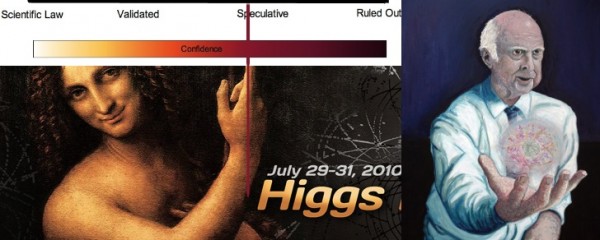
I think that the Higgs, until we discover it directly, is still a speculative idea, but I think it's a likely one. (The indirect evidence for it and against the Higgs-less models is pretty strong.) If I were a betting man, I'd say the odds were better than 50-50 that the Higgs exists, and that it exists in the mass range where we expect it.
But nature is often full of surprises, and one of the most interesting (theoretically, anyway) things that could happen would be for the Tevatron and the LHC to both find no Higgs.
So it's speculative right now, but even if we find it, there's still one more question that's going to arise.
Why are the masses of these standard model particles so different from one another?
The electron weighs in at only half of an MeV (0.000511 GeV for those of you keeping score), while the top quark tips the scales at more than 170 GeV (173.1 GeV, give or take about 1.3 GeV). The Higgs must have different coupling constants to each of these particles, but the standard model offers no explanation for either why or how. Plus, even though this gives particles a "rest mass" (what some people term inertia), it doesn't explain how things with mass gravitationally attract or interact. So even if we find the God particle, we still have a bunch left to learn.
Hope this has helped shed some light on the mysterious Higgs boson; what follow-up questions do you have?

I'm curious to see the reactions to you putting the Higgs as more speculative than inflation.
... instead of protons, they collided electrons and positrons. Based on measurements from LEP, the Higgs would have been discovered if it had a mass below 114 GeV, so we can be confident that if the Higgs exists, it's heavier than this.
How is the Higgs expected to manifest itself? Errr... apart from destroying the world of course! ; ) I mean is it supposed to leave tracks in a bubble chamber or something like that?
- Each of the six quarks comes in three different colors (red, white, and blue)
While i applaud your patriotism, shouldn't that be "red, green, and blue"?
Thanks. Nice summary and links.
One question. You say, "Maybe the Higgs, the only fundamental scalar (completely spinless) particle in the standard model, is forbidden? We've never observed a fundamental scalar before, after all."
I don't understand what "fundamental scalar (completely spinless particle" means. I know that a photon and gluon are bosons with spin zero. But you seem to be saying that a Higgs boson would have spin zero but somehow be different than a photon or gluon. I understand the words scalar and vector but I'm not understanding something different about the Higgs. Help please. Thanks.
Photons are spin-1....
I was unaware that quarks come in red, white, and blue. Are they American or French patriots? I suppose antiquarks come in cyan, black, and yellow?
I thought quarks came in red, green, and blue and anti-quarks come in anti-red, anti-green, and anti-blue. They then have to combine in some way that comes out white, e.g. red+green+blue or red+anti-red.
Jim @1, although the precision electroweak data is great indirect evidence, predicting the Higgs is much more ambitious than predicting inflation, which is more akin to predicting the Sakharov Conditions. We needed it, this is the only way to get it, therefore, it (or something very much like it) happened. But there are other ways to get mass than with the SM Higgs. It helps that within a few years, we won't be speculating on the Higgs anymore.
Pen @2, the Higgs will decay quickly, but its decay products will be visible in a particle detector, and will leave behind definitive, unambiguous signatures of a Higgs.
Cyphern @3 and Blaise @6, despite what wikipedia tells you, the colors aren't standardized. I learned "red, white, and blue" from a Frenchman. When I jokingly asked him if he meant "blue, white and red" (the French flag's colors), he told me I was in the wrong country.
Thomas @4, Doug is correct. Photons and gluons are known as vector bosons, and have a spin of 1. A fundamental scalar, which the Higgs is predicted to be, would be the first of its kind.
You say:
Mass of proton: .938 GeV
Weight of electron: .511 GeV
?
Is that supposed to be .511 MeV?
Just a minor nit to pick. The electron has a mass of .511 MeV/c^2 not GeV/c^2.
Nescio and Daniel, you're right! My bad, so look for the edit in a few minutes.
In the diagram above, you state that the Higgs can couple with itself giving it mass?
When the Higg's is found, or discovered, will multiple Higg's particles be collected? Or will those Higg's particle have to be kept separate from one another?
Being that the Higgs is called the "God Particle", how many Higg's particles are possibly needed to create a universe? We've heard or read that the initial mass of the Universe was somewhat the size of a pea that inflation or expansion lead to what we understand as the existing Universe.
If enough Higg's were collected and a subsequent mass of Higg's were bonded together, wouldn't that disrupt the fabric of the universe by the creation of a new folding of matter within the existing Universe?
If so, then wouldn't that still take several billion years to allow for the expansion/inflation of the Universe from the Higg's capture and stored?
Why would something like a LHC be able to 'find' a Higg's particle? It would seem that, ideally, a Higg's particle would reside or form inside a black hole or even a supermassive black hole.
I'm just thinking that is one of the reason that conceptually it is very difficulty for non-physicist or non-scientist to grasps the concept of finding a Higg's and what ultimately is learned in the discovery process.
When average people are sitting at a bar and having a few drinks with their friends, they usually talk about sports or some event that occurs in society. Why is that? Classical reality or the everyday norms one can wrap their head around, but getting into conversations about the nature of the foundation of the universe is very difficult conceptually for the majority to wrap their minds and thinking around these concepts of something like a Higg's.
Thanks for the interesting explainations and excellent article!
Jerry,
In the standard model, there's just one Higgs. If we find multiple Higgs, that's probably an indicator of either Supersymmetry or Extra Dimensions, or some other exotic physics.
But conservatively, there ought to be at least one, and not necessarily more.
The Higgs is very unstable, and so isn't volatile like you worry about. It will decay after a tiny fraction of a second into much less massive, more stable particles. At least, according to the standard model, which is very good.
But as for what's actually going to happen, I'm a physicist, not a psychic, so I need to wait for the experiment to bear out its results!
"... one of the most interesting (theoretically, anyway) things that could happen would be for the Tevatron and the LHC to both find no Higgs. "
That result would so interesting, so incredibly *cool* I can't even get my head around it.
Here my knowledge of non-Higgs particle physics is failing me, as I could argue that, as for inflation, we need something to break EW symmetry and give masses, so therefore something like it must have happened. One difference between the two, it seems, is the lack of a strong competing theory to inflation (not sure if you've devoted a column to the ekpyrotic scenarios).
Is the phrasing of "protons, neutrons, and nuclei" meant to imply that it is incorrect to think of nuclei as simply collections of protons and neutrons, or am I reading too much into it?
How do I explain to creationists that photons have no mass? They tell me gravity bends light so they must have some mass, but i tell them that this is a warping effect of mass on space/time and light just follows the curved path. Is this a good response?
This line of debate came from a creationist asking me to postulate something immaterial coming from something material, so I said 'light'.
Also, what is a massive photon if there is any such thing?
Great post, explains things very nicely.
The confidence scale used here is the same one as in the "dark matter on the sun" post, which makes the "today's entry" on the scale misleading.
What would happen if the Higgs boson is never discovered?
You wrote:
I think that the Higgs, until we discover it directly, is still a speculative idea, but I think it's a likely one.
But your confidence scale has a "Today's Entry" mark, close to Ruled Out, left over from the dark-matter-collects-in-the-sun item, I think.
Do you mean that Higgs boson is about mid-way between the Validated and Speculative marks?
Ethan@8: But -- if we include white as one of the quark colors, doesn't that kind of ruin the whole analogy with the RGB colors mixing together to become white at a distance? The choice of using RGB for the colors may be arbitrary, but there is a reason for it. Is there any advantage to using white in place of green?
Thank you Doug and Ethan
Yes of course, I just got mixed up.
Are you sure about General Relativity as Scientific Law in view of Dark Matter and Dark Energy problems. I would put classical electrodynamics as Scientific Law. About everything else, who knows...
Waydude@17: It would be more accurate to state that the photon has no rest mass (or inertia, as Ethan mentioned). But the energy that a photon carries with it is equivalent to a tiny bit of mass, and so you can think of that as what's being deflected as it travels through a gravitational field.
I'm guessing that a "massive photon" would be a photon of an extremely energetic frequency.
I've been patiently waiting for ethan to stop all the off-topic postings about the universe/physics/quantum mechanices/ect. and get back to cosmology. I have not seen one post about the latest hair cuts, new perm techniques or even hair care products. Now I found out that he's not even a psychic? Thats the last straw. I'm outa here...
How does the graph indicating 95% confidence of exclusion between 158Gev and 175Gev effect the possibility of top quark condensate at 173Gev? Or is it even relevant?
You should link the image of the plushie particles to their source so that everyone can have their own stuffed particles. http://www.particlezoo.net/
So, electroweak symmetry breaking implies a Higgs. But why do we think the Higgs has to couple to the leptons and quarks? That always seemed a little ad-hoc to me.
but I'm no expert.
If the Higgs couples to itself, what stops it from repeatedly coupling and blowing out its own mass until the idea itself is useless?
great blog! two things about The Leptons:
(a) (a nit) they're in the lower _left_-hand corner of the diagram.
(b) you say 15 types, but I count 18 in your description:
6 matter non-neutrinos = 3 (e, m, t) x 2 (spins +½ and -½)
6 anti-matter non-ns = 3 anti-(e, m, t) x 2 (spins +½ and -½)
3 matter neutrinos = 3 (en, mn, tn) x 1 (spin -½)
3 anti-matter neutrinos = 3 anti-(en, mn, tn) x 1 (spin +½)
did I double count somewhere? or otherwise not understand?
cmt @28 Not only that, but I've never quite understood how the Higgs field coupling to the W and Z makes them exhibit any of the properties we associate with mass OTHER THAN making the weak force short-ranged. I don't see how a screening effect leads to inertia for real particles. I don't see how a particle sitting in a screening field (especially a UNIFORM one) has more energy than one not in such a field. And I don't see how such a field causes a particle to move slower than the speed of light (unless it also causes more random behavior, like photons shoving through charged particles on their way out of the sun's core).
I know this article was about the Higgs... but in your description of the standard particles, you didn't get into the question I've always wondered about: the -1/3, +2/3 charges of the quarks vs. the -1e electron. That, by itself, seems to indicate something more fundamental (with a basic building block charge of 1/3 e). To me, that is as much a mystery as is the existence of the Higgs.
PS.. great site! I only recently found it and come back often to read your posts.
I did not know this. Is this what's meant with left-handed- and right-handedness? How does it even make sense? I know it's not in reality possible to send them through a simple filter like photons and, say, silver ions, but if our detector is oriented completely at random, how does it make sense to have only one direction? What if I turn the detector upside down? Shouldn't I then get the opposite value?
---
If gluons are massless, why are they confined to the nucleus? I thought that EM and gravity had infinite reach exactly because the photon and graviton are massless.
---
Why is the Higgs spinless? Assuming asking that makes sense.
---
I think that when Jerry asks how many Higgses are around, he means not different Higgses, but ... instantiations of the one type of Higgs. For comparison the Universe is full of electrons, but there are only three types of 'electron'. So I think the question was about whether Higgses can bond together to form some form of matter on their own.
---
Not only should you let people know where they can get their cuddle Standard Model, but you really shouldn't use so many images without giving credit to the originators. I do like that you use to many pictures in general, but it really jar that you effectively steal them without attribution.
Great write up Ethan!
Gosh, I usually regret what I am about to do, which is to be excoriated for publicly throwing cold water on the Higgs, etc., but this seems to be a literate and numerate blog so...you never know who might be reading with an open mind.
There are alternative theories of physics which do not require the Higgs. Most are fringe, meaning cranky lonely physicists slogging along unfunded. Some are credible.
One in particular uses Cartan's differential geometry to rigorously complete general relativity in the sense it becomes a generally covariant unified field theory, so a single theory, from which all classical and quantum laws can be produced, and all known observables are explained; many unobserved phenomena are discredited. So no "well, we cannot explain gravity" or "the neutrino has mass but shouldn't", or "we would like to run some string experiments but...."
So if and when you google Myron Evans and read his wiki page, you must ignore the detractors. Well, you of course may believe them, but then you are not open minded and will miss potentially the biggest advance in physics since at least Einstein. Hunt down his web sites and start reading. Of course, you will need to do the math to convince yourself and that will take time, but after all you are physicists.
@Sili 33 I was wondering the same thing about neutrino spins! But I can sort of answer two of your other questions...
Gluon confinement is directly related to the fact that gluons have non-zero color charge, and therefore interact with themselves. This drastically changes the dynamics of the force they mediate. If I remember the details correctly, this tends to cause them to form into tubules between quarks. This geometry causes the strength of the force to fall off MUCH more slowly than EM or gravity (which are both inverse-square in the classical limit, you'll notice) (I forget the specifics - is it linear, or constant, or does it actually INCREASE?) Anyway, this means that as you separate two quarks you're dumping more and more energy into this field. Eventually there's enough in there that it's energetically favorable for two NEW quarks (technically a quark-antiquark pair) to pop into existence, and you're left holding two mesons (or a meson and a baryon, depending on what you started with). I'm sure I'm omitting some important details, but that's the crux of it, and if you're a layperson like I am, it may be the most detailed explanation either of us can comprehend. But don't feel bad, QCD is apparently nightmarishly difficult to calculate, and even the experts' descriptions of it are somewhat broad approximations today.
There's a direct relationship between the spin of bosons and the mathematical properties of the force field they mediate. (This blows my mind, as someone who still usually thinks of spin simply as intrinsic angular momentum.) The electromagnetic field is a vector field (having magnitude and direction, and described by a single-column matrix), so the photon is spin-1. The Higgs field (assuming it exists) is known to be a scalar field (having only a value, effectively a 1x1 matrix), and is therefore spin-0. If the graviton exists, it would be a spin-2 particle because gravity (in GR) is a tensor field. I think of it as particle spin being the number of dimensions of the matrix that describes the field, though I'm sure that description would make a physicist cringe.
Thanks, BenHead.
Somehow I'd been thinking of mass-full mesons consisting of colur+anticoulour quarks making them overall colourless, and then moved that colourlessness onto quarks, themselves.
I would like a better understanding of what you mean by a scalar field. Why is the higgs field scalar and how does that affect the theory?
Probably a silly question but could the Higgs be Dark Matter? If it was capable at forming stable complexes at say very low temperature (eg out side galaxies?) and it only interacts via gravity then is it a candidate?
Look at Belgian patent BE1002781 pages 3-4 for the calculation of proton rest mass using angular momentum (spin) charge and average nuclear radius. The patent can be read in English through e-Cat Site in the article "Belgian LANR Patents". If correct Higgs particle giving mass to proton is superfluous.
Yes, if it is correct.
But it looks like it's entirely form-fitting.
Oddly enough, when you fit an equation to the values you have, running the equation to produce those numbers is going to give you the right figures.
ppnl, a scalar field means it has no direction, no vector component.
https://en.wikipedia.org/wiki/Scalar_field
If it had a direction (vector field), then it would act very differently:
https://en.wikipedia.org/wiki/Vector_field
and would result in different views of the same event depending on the location of either the event or the viewer.
@Steve Bannister #35:
Evans said that if a photon has mass, it would produce two extra fields. The only way I can get even one extra field is to assume the mass is variable, which would give (∂ - iA) m. (And yes I am open-minded; how else could I have written that sentence, considering that mass is supposed to be constant?)
I was curious to see what he said the other one was. I found that his descriptions of the fields have nothing remotely similar to this, and make no sense at all. Apparently, he has no idea how to do vector algebra.
He can't even handle the classical flat Poincare group. And you trust him with quantum gravity???